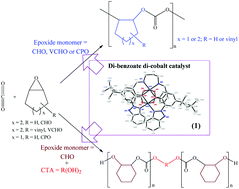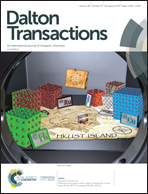Synthesis and characterization of di-nuclear bis(benzotriazole iminophenolate) cobalt complexes: catalysis for the copolymerization of carbon dioxide with epoxides†‡
Abstract
A family of di-nuclear bis(benzotriazole iminophenolate) (BiIBTP) cobalt complexes containing diverse ancillary carboxylate derivatives have been synthesized and structurally characterized. The one-pot synthesis of the BiIBTP ligand precursor with cobalt perchlorate salt (2.0 equiv.) and carboxylic acid derivatives (2.0 or 5.0 equiv.) in the presence of triethylamine (5.0 equiv.) under refluxing methanolic solution generated bimetallic di-carboxylate Co(II)/Co(II) complexes [(C83CBiIBTP)Co2(O2CR)2] (R = C6H5 (1), C6F5 (2), 4-CF3–C6H4 (3), 4-OMe–C6H4 (4), CF3 (5)) in ≧65% yields. Interestingly, the Co(II)/Co(III) mixed-valence complex 6 resulted from the treatment of 1 with silver perchlorate (1.0 equiv.) as the oxidizing agent under an O2-atmosphere in 50% yield. The crystal structure of 6 reveals an ionic and di-nuclear benzoate species composed of a cationic moiety formulated as [(C83CBiIBTP)Co2(O2CC6H5)2]+ and a counterbalanced perchlorate anion, and both metal atoms are attributed to hexa-coordinated cobalt ions with varied coordination environments. Catalysis results of CO2/epoxide copolymerization indicated that complex 1 was more efficient than 2–6 where compound 6 was shown to be the least active. Co complex 1 incorporating benzoate coligands was demonstrated to effectively catalyze the CO2-copolymerization of cyclohexene oxide (CHO), 4-vinyl-1,2-cyclohexene oxide or cyclopentene oxide, producing the associated CO2-based polycarbonates with >99% carbonate repeated units under optimal conditions. Not only the controllable character of complex 1 for CO2/CHO copolymerization is enabled, but also 1 has been shown to catalyze such a copolymerization in the “immortal” manner. Using the same di-cobalt catalyst in combination with excess ratios of neopentyl glycol (up to 150 equiv.) as the chain transfer agent could give low molecular weight poly(cyclohexene carbonate) polyols with monomodal molecular weight distributions. This work offers the facilely prepared di-nuclear cobalt complexes as catalysts for the efficient catalysis of CO2-copolymerization.



 Please wait while we load your content...
Please wait while we load your content...